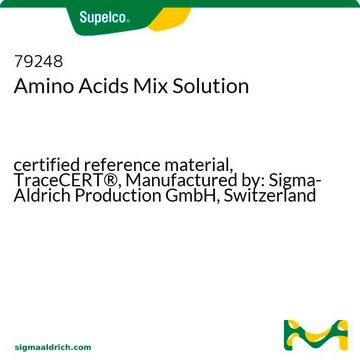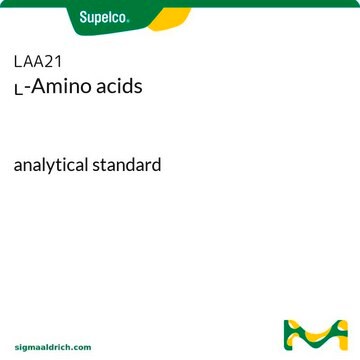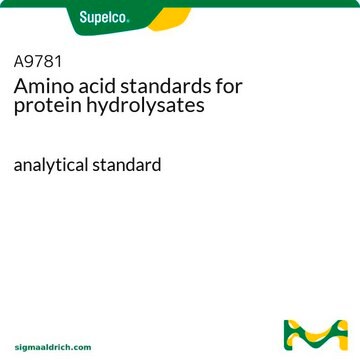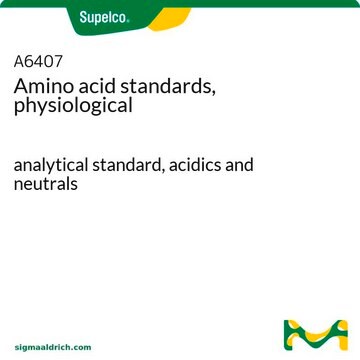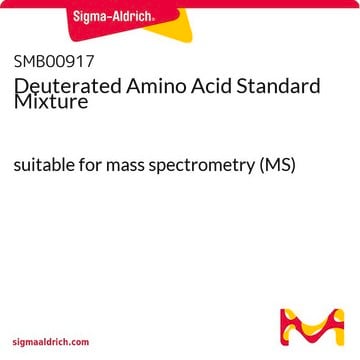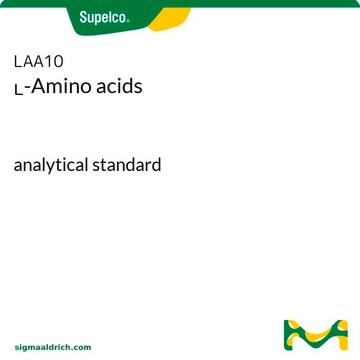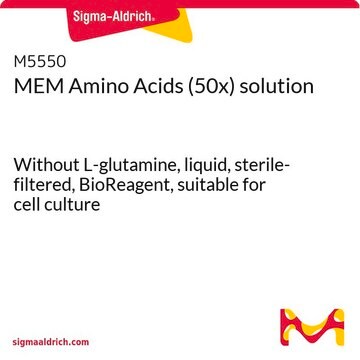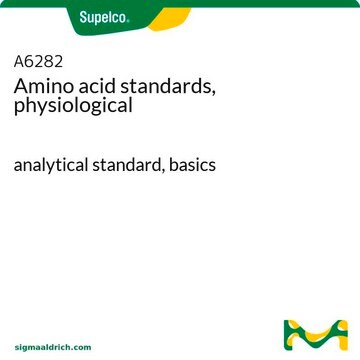Recommended Products
grade
analytical standard
shelf life
limited shelf life, expiry date on the label
analyte chemical class(es)
amino acids, peptides, proteins
technique(s)
HPLC: suitable
gas chromatography (GC): suitable
application(s)
food and beverages
format
multi-component solution
storage temp.
2-8°C
Related Categories
Application
This analytical standard was used as follows:
- Determination of L- and D-amino acids and glycine by liquid chromatography-tandem mass spectrometry (LC-MS/MS) following their derivatization with chiral Marfey’s reagent
- High-performance liquid chromatography (HPLC) based amino acid analysis during the characterization of defatted rice bran (DRB) protein concentrate to evaluate its iron binding ability
- Development of a gas chromatography-mass spectrometry (GC-MS) procedure for the profiling of 112 amino-carboxylic metabolites in human urine samples using 1,1,1,2,2,3,3-heptafluorobutyl chloroformate for derivatization and liquid-liquid microextraction for sample treatment
- Non-enantiomeric detection and quantification of amino acids in their various forms— free, dissolved, particulate, and total, in natural water samples by HPLC coupled with fluorescence detection using a C18 column
Packaging
1 mL size packaged in flame sealed ampules.
Components
The following components are included in the amino acid standard:
- L-Alanine
- Ammonium chloride
- L-Arginine
- L-Aspartic acid
- L-Cystine
- L-Glutamic acid
- Glycine
- L-Histidine
- L-Isoleucine
- L-Leucine
- L-Lysine
- L-Methionine
- L-Phenylalanine
- L-Proline
- L-Serine
- L-Threonine
- L-Tyrosine
- L-Valine
Other Notes
Amino acids in this standard are 2.5 μmoles per mL in 0.1 N HCl, except L-cystine at 1.25 μmoles per mL.
related product
Product No.
Description
Pricing
signalword
Warning
hcodes
pcodes
Hazard Classifications
Met. Corr. 1
Storage Class
8B - Non-combustible corrosive hazardous materials
wgk_germany
nwg
flash_point_f
Not applicable
flash_point_c
Not applicable
Choose from one of the most recent versions:
Certificates of Analysis (COA)
Lot/Batch Number
Don't see the Right Version?
If you require a particular version, you can look up a specific certificate by the Lot or Batch number.
Already Own This Product?
Find documentation for the products that you have recently purchased in the Document Library.
Affordable Processing of Edible Orthopterans Provides a Highly Nutritive Source of Food Ingredients.
Forkwa Tengweh Fombong et al.
Foods (Basel, Switzerland), 10(1) (2021-01-16)
Edible orthopterans (grasshoppers, crickets, and locusts) are major delicacies, especially across sub-Saharan Africa. Their promotion as food ingredients is increasingly gaining momentum. This study evaluates the nutritional profiles of three widely consumed orthopterans: Gryllus bimaculatus, Locusta migratoria, and Schistocerca gregaria
Yu Liu et al.
Metabolites, 10(8) (2020-08-06)
Glucosinolates are a group of plant secondary metabolites that can be hydrolyzed into a variety of breakdown products such as isothiocyanates, thiocyanates, and nitriles. These breakdown products can facilitate plant defense and function as attractants to natural enemies of insect
Jan Rozsypal et al.
The Journal of experimental biology, 221(Pt 7) (2018-03-03)
Some insects rely on the strategy of freeze tolerance for winter survival. During freezing, extracellular body water transitions from the liquid to the solid phase and cells undergo freeze-induced dehydration. Here, we present results of a thermal analysis (from differential
Halli S Weiner et al.
Biology of reproduction, 100(5), 1261-1274 (2019-02-05)
Spermatozoa from three feline species-the domestic cat (Felis catus), the cheetah (Acinonyx jubatus), and the clouded leopard (Neofelis nebulosa)-were analyzed using metabolomic profiling and 13C-based fluxomics to address questions raised regarding their energy metabolism. Metabolic profiles and utilization of 13C-labeled
Chang Xu et al.
Evidence-based complementary and alternative medicine : eCAM, 2020, 9784382-9784382 (2020-05-10)
Type 2 diabetes mellitus (T2DM) has become a major disease threatening human health worldwide. At present, the treatment of T2DM cannot cure diabetes and is prone to many side effects. Psidium guajava L. leaves have been reported to possess hypoglycemic
Our team of scientists has experience in all areas of research including Life Science, Material Science, Chemical Synthesis, Chromatography, Analytical and many others.
Contact Technical Service